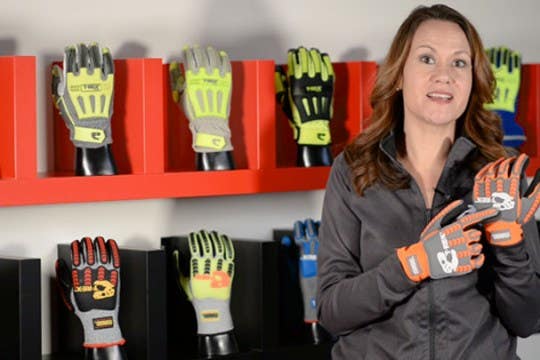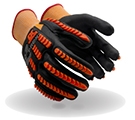
ANSI/ISEA 138 Impact Gloves Standard Explained
When it comes to impacts and hand protection, the laws of physics give you only two options to soften a blow. You can slow the impact down or you can increase the distance between the impact and the vulnerable body part.
How Impact Resistant Gloves Protect Your Hand
The same rules apply to impact gloves. An impact-absorbing material like thermoplastic rubber (TPR) on the back of a glove lessens impact force when:
- Its thickness increases the distance between the impact and the hand.
- Its elasticity smashes, or “gives” a bit to increase how long the impact lasts.
As Lucy Nobrega M.S.M.E. explains it, it’s a similar principle to someone jumping out of a burning building into a stretchy fireman’s net or the crumple zones in your car that delay impact in a crash. The placement of an impact-absorber across the entire back of the glove also serves to spread the impact force out, lessening the damage at any particular point.
How Impact Glove Testing Works
In the past, choosing an impact glove was a bit of a guessing game. But the ANSI/ISEA 138 Impact Glove Standard finally put some numbers on the science of protecting your workers’ hands from impacts.
To perform the impact test, an independent and accredited ISO/IEC 17025:2017 lab ensures that all gloves tested are kept in the same environment, right down to the temperature of the glove. Then they:

Cut the palm off the glove so they’re testing only the back of the glove’s shell and the impact-absorbing material.

Place the glove-half on a curved metal anvil.

Drop a striking mass that weighs about 5½ pounds onto it to simulate an impact on the job. A special force transducer underneath the anvil measures how much force got through.

Repeat the test for each knuckle, each finger, and the thumb. The lowest performance measurement is what counts for the whole glove.
What Impact Glove Ratings Mean
You may have seen the term, “mean transmitted force” in impact testing tables. That just means that the test measures how much impact force on average would travel through the glove to a worker’s hand. Based on the result, they assign the glove a Level 1, Level 2, or Level 3 rating. The higher the glove rating, the better the protection. Level 1 gives you the least protection. Level 3 gives you the most.
In lab testing,



The ANSI/ISEA standard and the guidance it gives are good news for managers and workers alike — because safety should never be a guessing game!
TAKE A LOOK AT THE BEST IMPACT GLOVES






